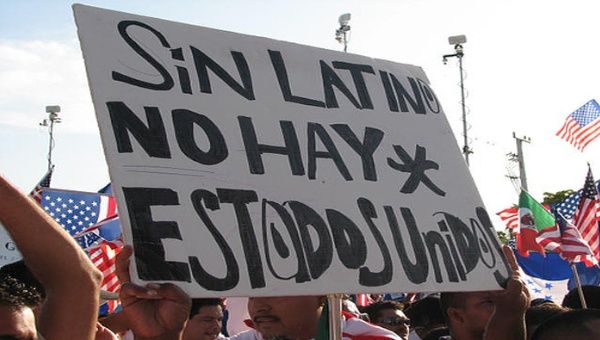Notes on the Latino Vote for the 2024 U.S. Presidential Elections

One of the indicators to take into account for the presidential elections coming up in November 2024 in the United States is the Latino vote, which may become increasingly significant and defining, and may be influential in achieving a greater number of votes.
According to the U.S. population census update in December 2023, the Latino population is 63.7 million, representing 19.1% of the total U.S. population. Of these, 34.5 million Latinos are eligible to vote representing 14.3% of the entire U.S. electorate and exceeds the number of voters of African descent who represent 13.6% of the electorate[1]. According to the Pew Research Center, approximately 36 million are estimated to be eligible to vote in 2024.
The Latino vote is traditionally inclined toward the Democratic Party, although it can vary by county within a state. For example, in Florida, Miami Dade County has a large concentration of Cubans who lean toward the Republican Party; however, at the state level, Cubans represent 34% of Latinos to 57% of non-Cubans. This has meant that, on occasions, even when the Democratic candidate obtains a higher percentage of the Latino vote in the state, a conglomerate of a county gives more votes to the Republican Party and can define the vote in that state.
There are states like Maine, Montana and Vermont that even with a small Latino population have a high percentage of eligible voters (70%, 68% and 65.9%) respectively. There are others like New Mexico, where the Latino population is 50% of the total, only 62.7% are eligible to vote.
If we analyze some of the characteristics of this ethnic minority, it becomes apparent that the Latino population has traditionally voted in smaller proportion than any other minority, which occurred until 2018 and 2020 when there was an upsurge in their participation.
In 2000 Latinos to vote represented 7.4% of the electorate; in 2008 9%; in 2012 10%; in 2016 11%; in 2018 midterm elections 12.8% of the electorate and in 2020, 13.3%. In this last year there was a turnout of 18.7 million Latino voters, for a 53.7% presence at the polls[2]. According to Matt Barreto, political scientist and professor of Political Science at UCLA, proportionally to the national vote, the Latino vote increased by 30% and the national electorate by 15%, a trend that is expected to occur in the 2024 elections due to their demographic growth, the consequences of immigration and the arrival of a greater number of 18-year-old Latinos.
Donald Trump, although he lost the 2020 presidential election, gained an advantage among Latino voters in several key states he had won in 2016. He took 32% of the Latino vote versus 28% four years earlier[3]. A CNN poll showed that, in 2020, Biden won 66% of the group nationwide.
The average age of the Latino voter is 39, which is a young vote that is becoming more liberal-leaning compared to the average 48 year old general voter, even though there is currently dissatisfaction with President Biden’s performance among that younger population.
The highest concentration of Latinos is in some of the states with the highest number of electoral votes: California (55), Texas (38); New York (29); Florida (29); Illinois (20) and Pennsylvania (20).
A retrospective look at the 2020 elections shows us how in Arizona with 25% of Latino voters, Biden won by a difference of 0.3%; California with 32% of Latinos eligible to vote is considered a blue state and should remain so; Florida with 21% should continue to bet on the Republican Party, which takes advantage of the anti-socialist narrative and conservative positions on cultural and religious issues that mainly Cubans and Venezuelans support. In Georgia, with 6%, Biden won by 0.23%; while Texas with 32%, swung to the right. This is something to keep in mind in these elections since there are 6 million Latinos eligible to vote, but about half of these are not registered and therefore not part of the campaign so far but could still be incorporated. In Texas, Trump obtained 41% of the Latino vote, which helped him win the state for his presidency.
The margins that occurred in 2020 should not perform the same way in 2024, as the latest polls indicate that although Latinos will continue to support Democrats, they will do so with smaller leads. According to the FIU-backed Annual Hispanic Public Opinion Survey, Latinos have decreased support for the Democratic Party and some are even choosing not to affiliate with either party, which would have a greater impact on Democrats. A 2021 Gallup poll found that 52% of Latinos identified themselves as independents.
Another survey of 1221 Latinos by the Latino Public Opinion Forum of the FIU Public Policy Institute in 22 states with the highest concentration of Latinos, 45% did not want Biden to run and 57% did not want to see Trump on the ballot.
Each nationality has a different outlook that also varies according to several factors and one of the characteristics to highlight from 2020 is that the native Latino population has naturally grown. It is an increase not driven by immigration, which has repercussions from a political standpoint because of higher voter registration.
To have an idea of the number of Latinos by country of origin according to the last 2020 census, there are 59.5% Mexicans; 9.8% Puerto Ricans; 4% Salvadorans; 3.8% Cubans; 3.8% Dominicans; and 19.2% others. These figures must already be higher. According to the Pew Research Center, 66% of Latinos eligible to vote live in 5 states: California, Texas, Florida, New York and Arizona in descending order.
The increase in the number of immigrants in the United States has led to the claim that Latinos in places like California are no longer a minority, which becomes important in light of the political implications and other considerations.
To capture this electorate, it is essential to understand that Latinos are not a monolithic conglomerate and success lies precisely in discerning their diversity, their origins, where they come from, gender, age, education and places of residence. Rather than leaning to one party or another, Latinos look for the solution of their interests, which are dissimilar and require a personalized work by the candidates.
Their issues of concern are the economy, inflation, health services, education, gun violence, safety and abortion. The immigration issue, although of interest, fluctuates and does not outweigh concern for the economy.
So far Latinos have shown high levels of abstention which affects the chances of a higher incidence of their vote. It gave Biden a margin of victory in at least four swing states: Arizona, Wisconsin, Pennsylvania and Nevada[4]. The states of Wisconsin and Michigan, although they have a smaller presence of Latinos, could have a higher proportion of those eligible to vote. In that sense, University of South Carolina professor David Darmofal told AFP that the states of Nevada, Arizona, Wisconsin and Georgia will play an important role in the 2024 elections and especially certain counties in those states may be able to attract the utmost attention. The task of handling this conglomerate for the upcoming elections is a true challenge that can comprise the rest of the other ethnic minorities, such as African descendants, who traditionally vote for
[1] Pew Research Center data.
[2] CUNY University of New York study.
[3] Pew Research Center data.
[4] Pew Research Center data.




Déjanos tu comentario